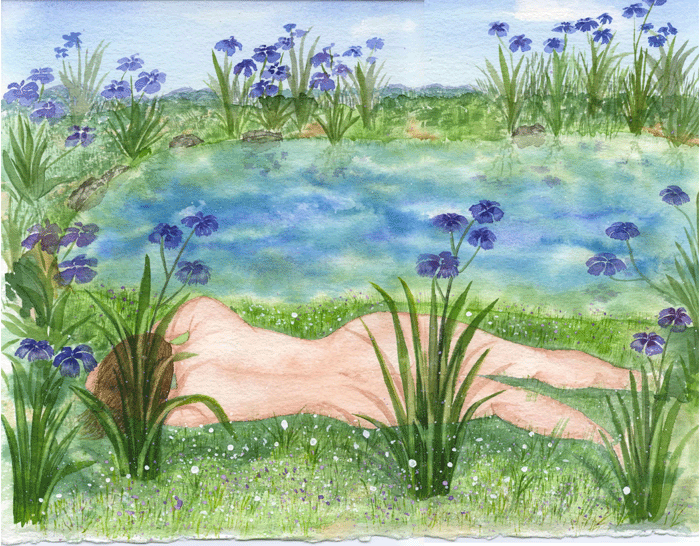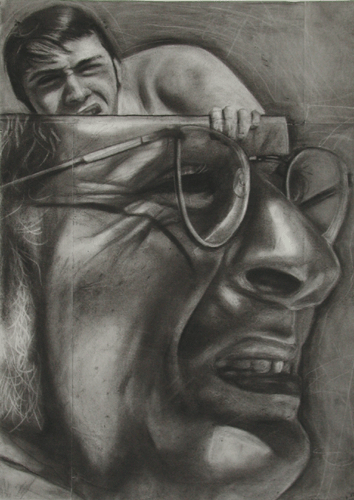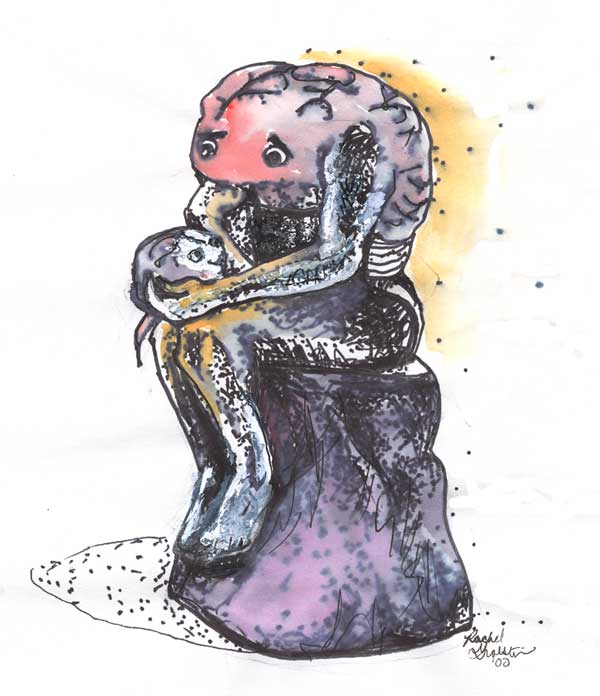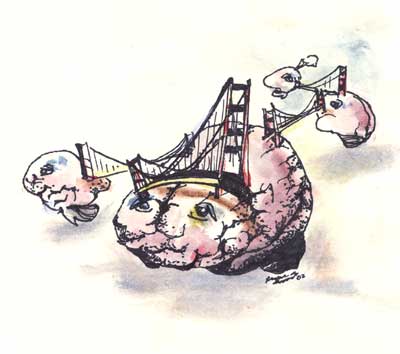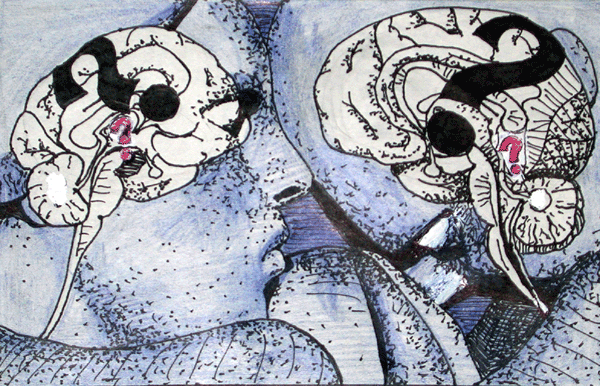In the forum continuing the conversation he initiated with René Descartes, Paul Grobstein asked,
Are there differences between words and pictures as ways of thinking? Individually? Collectively? As ways of story sharing? Individually? Collectively?...
and gave the answer that, to him, paintings seemed
to represent something quite different from "dialogue":...story comparing, with the intent...to test the usefulness of particular stories....for that purpose, stories need to be... "assailable"...in a form that facilitates comparison with and testing against other stories.....Words...make it possible to break apart some of the unity of feelings/intuitions/etc in a way that makes it possible to ask questions about and compare/contrast different parts of the whole.... more "assailable," more subject to common testing.
We want to use both words and pictures to work through, and to "worry," that distinction a little bit here....
Elizabeth:
....why are we using the word assailable rather than say accessible?
Anne:
This? Actually? Seems to me, Elizabeth, the crux, the place the road forks....
Reading Sharon's description, on the Descartes forum,
of how violent it felt, to have her image altered for our class,
contrasting that with my own very positive sense of what happened,
I am thinking there's a difference between artists (who want their work to be accessible)
and critics (for whom it must be assailable/interpretable/re-writable). This of course both goes back to and takes off from Paul's comments, above....
So: now I am wondering if all the reading/work you've done with conceptual art and installations
might work well across that tension: the sort of art that invites the viewer in,
and in so doing, opens itself to being changed by the viewing...(fits with some physics theory I've been reading lately, Stapp's The Mindful Universe).
Sharon:
Perhaps indeed as you said, assailable vs. accessible is the crux. But
again, these two words have distinctly different meanings for me.
Assailable carries an intent to challenge, analyze, question, pull
apart.
Accessible carries an intent to communicate, send something of oneself
to another, or suggest something to pull something out of someone else.
The former implies an intent at likely decomposition; the second asks
that what is offered to be considered as is.
I also thought of something else in my experience that may describe
more generally for other artists (?) their relationship to their
work/art and the impact of assailable vs. accessible. This is about the
signing of one's work. (As you know, Anne), I never sign my paintings, and
moreover when pushed to explain myself on that point, I realized it was
no casual oversight but a deep aversion to putting my name on my
paintings. In part, since they are often gifts to specific people,
there's no need of my name to appear: they know who painted it. But
after pushed to consider the issue more, I realized my resistance to
signing was deeper than this. Someone else gave me this idea and I
think it is right on the mark: I don't want to put my name on the
painting because to do so would separate the painting from me and the
painting IS me, it is a reflection of the interior of me. This is
exactly how I feel about my paintings. Not all artists may feel the
same attachment of themselves to their work--I don't know, Elizabeth,
how do you feel? But, in cases where one's art IS the expression of
themSELVES, and becomes an extension of themselves, it makes a lot of
sense why assailability would not be desired. It would be the
challenging, analysis, questioning and pulling apart of one's self. The
loss of the unity of the experience, which Paul said was part of the assailing process.
Elizabeth (Anne, you can listen in), I realized that I was so
enthusiastic to read your responses in the forum because I had been lacking someone to talk with about the artistic process, how they
listen to their inner creative experience. And I sure do want to see
your installation!
Anne:
Yes, we're going to have to figure out how to get that installation on-line. Until then: I had been thinking for some time now how much Elizabeth's work, for me, intersects with--actually seems to pick up on and play with a whole range of--Sharon's images (for instance: what do you see, Elizabeth, when you look at in these paired paintings?)

Sharon Burgmayer, Seascape |

Sharon Burgmayer, Shell |
What is even more striking to me now is the congruity, not only between your images, but between your concerns about what it might mean for you if they become publicly available, and so assailable. Elizabeth asks why we're talking about "assailable" rather than "accessible," and I think Sharon explains why that word is troubling: because making her paintings "assailable" would be "challenging...questioning and pulling apart" herself. I do not think of myself as an artist like you guys, but I do make lots of things (webpages, articles, books, classes...) which I make freely and publicly available--and it's precisely their assailability that I revel in. When I made my first foray into this now multiply-expanded discussion, in We Are, and We Can Talk, Therefore...I Am a We... I described the self as "within itself, porous and multiple, as the self constantly takes others within itself," and talked about the pleasure I found in the "risk of connecting, really connecting, with another--in that uncertain space where the outcome of the interchange is not predictable." To me, being assailed is not being assaulted, but rather ingesting what others have to offer in response to my own offering: chewing it over, making (or deciding not to make) it part of myself.
What I enjoy about the art work of you both is that you put yourself in it/out there, for me to see/ingest/assail....it's part of re-making who I am: an insistently social/socially assailable/ever-evolving self.
Sharon:
Regarding "the pleasure I found in the 'risk of connecting, really connecting, with another--in that uncertain space where the outcome of the interchange is not predictable.' To me, being assailed is not being assaulted, but rather ingesting what others have to offer in response to my own offering..."
Seems like one first needs to be secure in themselves to allow, even enjoy, being digested by others.
Elizabeth:
I value opening up.
I was thinking about footprints. So I asked people what they thought about
when they thought of footprints and everyone said sand. When footprints
happen they are not permanent. The artist Anna Mendietta worked by pressing
her body in the sand... making imprints, body prints. A site about Buddhism
said, "If you were following someone across unfamiliar ground you would look
for their footprints as a sign, as reassurance that they had been there and
you were going the right way." Also "prior to his death the Buddah left an
imprint of his foot on a stone near Kusinara, a reminder of his presence on
earth." I've been thinking about Buddhism a lot in conjunction with some
things people have been posting and Jody Cohen was apparently doing so too. I
do not really know too much about Buddhism.
Sharon, I was so excited by your post and feel the same way about having
someone to share process ideas, to talk to about art!....I have long admired your
work in Anne's office and on the web and feel like Iíve found a real kindred
artistic spirit! ...Maybe we can art together sometime (with Anne too?)
I feel the same way about the signature. In terms of what I've done with
that feeling I've not been consistent. Sometimes I have signed work and
sometimes I have not. I like the work that I have not signed better than the
work I have signed b/c the signature intervenes in the work in ways I would
not like it to. Nothing in any installation that I've done's been signed. My
art is very much me and I've got an interesting appearance vs. reality battle
constantly going on--so that when most people see what I do, at first, they
wonder why that in particular is coming from me. Or so that is my perception.
It could be wrong.
Anne:
Well, Elizabeth, here's a new and interesting thought! You begin with the transitory nature of footprints, but your examples all have to with imprints that remain: reassurances, reminders (traces, mementos...). They put me in mind of an activity my kids have done several times, in several different venues: measuring their "individual footprints" = how much of the world's resources they use (see both Global Footprints and Ecolological Footprints of Nations for more on this as pedagogical idea).
So I guess the game here is being responsible for just how little/how much influence we have on the shape of the world: not overvaluing it/thinking we are too important-or-permanent, but also recognizing the lasting/lingering traces of the "prints" we leave. This seems not so far different from Paul's mention, in his interim report, of Brecht's observation that "each one can now be seen as the centre, or none at all."
It might also give us a useful way to think some more about both your and Sharon's disinclination to sign your work?
Elizabeth:
Anne, do you remember the first time that we did art together and you said how explosed you felt?...And it was better for you if I didn't say anything [about your art], like "that's really good"?...I'd just like to ask you, Sharon, if you agree with me, that this never entirely goes away, even if you've been at visual
art for a while--this feeling of fear of emotional exposure. Please tell me
what you both think of this--This was a point where Anne didn't want to be
assailed or accessed--wasn't it--was it just because you were in the process?
If I went up to your office and told you that I really loved one of your
pieces, would you be o.k. with that?
Anne:
Yes, Elizabeth--I didn't want you to comment on my initial steps in artmaking while I was in the process; it made me too self-conscious in an activity where I was very tentative, very much a novice. Afterwards? I think I'd welcome comments (though, sure, I'd be somewhat dismayed by negative ones)....
I've just noticed a new dialogue between another artist (whose work is very different from yours) and her father. Rachel Grobstein "interrupted her vacation" to speak about "the self constantly taking others within itself":
Descartes was using himself as an object of study...didn't in fact attempt to take himself out of the picture at all. (To study, for instance, Humanity as some abstract concept.) Indeed, he was the picture....And it seems any examination of "I", using thought or otherwise, points to very much the same conclusion: that "I" changes. Thought itself changes who one is... processing and understanding...the product of someone else's consciousness, places a new set of ideas in one's head; and certainly, one's sense of self is influenced by the sets of ideas one has...is also to break down the distinction between one's self and other....To have the thought is to make it a part of one's self, but the words come from something other than the self; the thought is both a part of one and not one, suggesting that the self is neither static nor a self contained entity. (I came across a version of that idea in my Zen class...)
Anne:
Hi, Rachel. Here's what you (taking off from vacation) have gotten me thinking about. Your saying, so strikingly, that Descartes "was the picture" has just called up another comparative "gallery" my (very un-Zen-like) mind generated about a year ago. When your dad and I were updating our
College Seminar on Storytelling, I paired one of your pictures with one of Sharon's as images to evoke the key idea of the initial section of the course--"reading and revising ourselves":
We didn't happen to use this particular pairing to elicit responses from the students in the class web forum, but now I'm curious to know how you'd respond to the questions Sharon raises above, about how commonly art is understood as an expression and extension of the painter, whose interior is reflected in (and so needs to be protected in the exhibition of?) her art.
I'm noticing, for instance, that you've painted a very striking sequence of "interiors" that are "neither static nor self contained":
Rachel Grobstein Gallery
Rachel:
Hi!
Whew - sorry this took so long, I have to admit I needed a few days to sit on the ideas, mull what was possibly worth saying. I'm always a little bit intimidated by the vastness of those forums Dad loves so much; so many trains of thought to pick up and comment on, but which one, which one?? Anyways, this is in answer to your conversations about assailability and accessability in art. I hope it contributes, and thanks for including me in the conversation. (Good to know you're following the evolution of the brain pictures too - a fan!)
Man - a big can of worms, this business about what exactly is expressed in artistic expression, and how a viewer (assailant?/accessor/or whatever title you prefer) is to go about looking at a piece of art, or engaging in a dialogue with it, or doing whatever it is one does with art.
In my own experience, I have always been less interested in 'saying something' with a piece of art than in raising possibility, hinting, suggesting - 'getting
at' a notion - and as such I have never been particularly concerned with what (exactly) a viewer takes away from my picture (though it would be nice, admittedly, if the viewer is interested in some way or another). Which is not to say I feel detached from what I create, or that I arrange images in an attempt to provoke a random response in viewers, or that I don't consider the art I make to be an extension of myself. On the contrary, what I paint may be to me a very engaging and evocative picture of a sensation or an idea, but it is not the sort of idea or sensation that could be easily translated into words, which suggests to me that the sort of communication I am opening with my viewer is not one that should follow the same methods and guidelines as language.
Indeed there is something especially in the nature of images and color (compared with words) which seems to suggest an exploration of associations, an opening of possibility, rather than the narrowing down of definition. With words, often one knows what one is trying to say, and the purpose of saying something is to define that idea, to fix it, to deliniate, to establish - to draw a very small box around the concept so that other people can understand (yes, to make the idea both accessible and assailable). But the very notion of purpose limits one's flexibility in exploring an idea. With images (and with words too, which Heidegger wrote about, but so much more easily with images) significations are so clearly not fixed; one can easily move between definitions, between ways of getting at or thinking about a particular thing. Instead of attempting to arrive at an idea, a definition, one can constantly suggest, without ever becoming fixed. And that's the sort of exploration I love in painting - the ability to start with a notion that is loosely or strictly defined - "my mother" or "my brother's relationship with my father", for example - and see what comes of it in a way that takes myself by surprise.
What I'm saying is that it's much harder to escape the notion of "saying" something (no joke intended) when one is using language than when one is using pictures. And I like very much the idea of not trying to translate the very goopy mess of my impressions into something as close to universally understandable as possible, which is exactly what I try and do every time I open my mouth. I'd rather paint something that is meaningful to me (stress on the meaningful, rather than the meaning, because a painting hardly ever carries a specific meaning for me, again, a meaning that I could translate into words) and whatever anybody else wants to take from that image - wonderful. I'm interested in what the viewer takes from the painting - what is meaningful for him - and as far as the viewer wishes to deconstruct my painting, and report what he thinks I am saying, I will say in return, "huh". Insofar as I paint who I am, a "non static and non self-contained" thing, to keep with that particular phrase, my painting is also not a static thing; and so I am happy to entertain the idea that whatever the viewer thinks of my painting (or thinks I am trying to do with my painting) may change the way I myself view the painting. But - and I think this is perhaps the main difference between Sharon's and my notions concerning the viewer/painter interaction - I don't see a necessary connection with the viewer's experience of my painting and with me, even if I do regard the painting as an extension of myself. I would say that my experience of a painting is largely what the painting means to me - and, unrelated - let the painting serve as a departure point for whomever wants it for wherever they end up going.
In a nutshell (ha) - that's what I think I'm doing (but bear in mind, I maintain that some of the beauty of the artistic creation is its untranslatability) when I paint. Hope this contributes, and thanks for the thought, for including me in the discussion (even if it is interrupting my tranquil vacation).
Anne:
One last interruption?
I've been thinking a little bit more, not just how your use of your artwork & your acceptance of its reception differs from Sharon's,
but how your representation of self, itself, differs too....
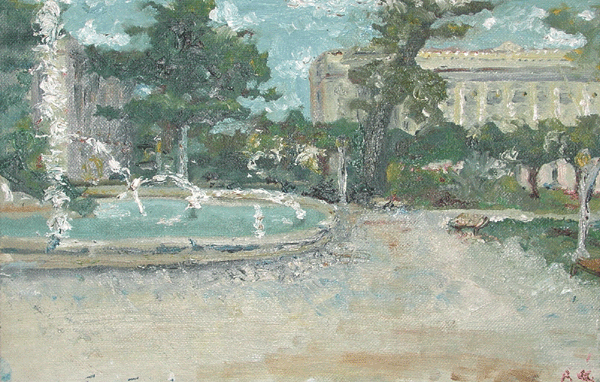 | (Is that a ghost of you represented in the fountain on the left? And you in the painting on the right...?) | 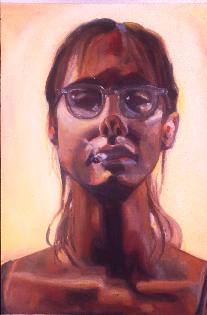 |
Rachel:
Hi!
Aha! Figured I couldn't have hit everything the first go round. To answer: in the painting of the fountain, I didn't intentionally put in a representation of myself, no. I was aiming for a pretty straight forward impressionistic cityscape. It's an interesting projection of yours though, especially given that I did paint another picture during the same period of time of an enormous building downtown with my face reflected in the windows (wierd that you wondered about the same sort of juxtaposition with the fountain painting). I get a very visual kick out of such surreal jammed-together images, and indeed I like very much the notion you seem to be getting at in that the projection of an image of myself directly onto an "other" creates an ambiguous sort of space, where the self is opened to the encroachment of the other and vice versa. The resulting painting can generate an interesting way of thinking about the breakdown between self and other: "self" (if one imagines the painting to be a projection of the self), and "other" (in the sense that the painting is literally a physical object, composed of paint on a surface, and also in the sense that the image of a landscape represents an exterior sort of reality) blur with self-representation (in the literal self-portrait itself - a face - and in the depiction of one's spacial interaction with the physical objects depicted). The blurring (if you're still with me - what a convoluted sentence!) seems to ultimately create a representation of the process of the painting itself. And that's what I have to say about that!
The page looks great, no edits! I'm very interested to see what comes next of the discussion, how this sits with everybody else. I've never put into words such a comprehensive concept of painting before and I'm eager to know how much of my wandering makes sense and which parts resonate with others. Tis a pretty interesting thing you're putting together!
Jody:
First, let me say that I've really been enjoying both the artwork and the words
on this page. Thanks for sharing these! I don't exactly think of myself as an
artist but in the last few years I have been playing with, doing--and
appreciating--visual arts. And I find that I'm deeply taken with some of the
ways that for me images are working differently from words, for example, the way
that "intention" plays out--and this involves the role of the conscious mind and
also 'the self,' which you've been writing about in such provocative ways in
this forum. So I've been trying to consider how this works for me doing art,
and why at this time in my life I'm so drawn to art and connected with the
process of making pictures in a way that feels substantively different from the
experience of writing (which I've done and considered 'my form' for basically my
whole life). And I think the times that I'm most in this very connected sort of
intrinsic-feeling place making pictures is when I'm coming from a strong, clear
vision, sometimes a dream or other times just an image that I feel compelled to,
what, move from an inner view to some kind of realization outside me. But the
funny thing is that even though in some sense this seems totally about me--my
insides out there--what I feel is so compelling is that it feels also not about
me at all. So I feel kind of not 'responsible' for images in the way that I
feel responsible for my words. Now as I'm writing this and so sort of thinking
it through in this way, I wonder whether some of this is about where I am in
this exploration--that is, I feel totally exploratory, have no 'training,'
little sense of right or wrong other than some sort of truthfulness to that
internal sense that expresses itself as an image. I don't usually make my
pictures public so haven't contended in that way with the sort of exchange that
some of you have talked about. So I really haven't dealt with either
'assailability' or 'accessibility.' Do you think it's possible to retain this
kind of beginner's experience? Though on the other hand it must be wonderful to
put your work out into the world, to experience what others make of it--whether
or not that changes your own sense of that work, wouldn't it deepen/enrich your
understanding in ways that matter in later work. I like a lot the way that
Rachel talked about 'encroachment' of self and other--okay, there's yet another
word. Look forward to where this will go next--?
Elizabeth Catanese picks up on some of these questions in
"An Effort in Collaboration": Immediacy and the Slowness of Time.
See also on-line forum for continuing conversation and to leave your own thoughts.
| One Woman's Exploration
| Writing Descartes Home Page
| Descartes Forum
| Science in Culture
| Serendip Home
Send us your comments at Serendip
© by Serendip 1994-2004 - Last Modified:
Monday, 09-Aug-2004 11:18:33 EDT
